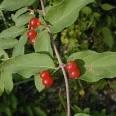
morrow honeysuckle
Lonicera morrowii
Cycle:
Perennial
Watering:
Average
Hardiness Zone:
4 - 8
Flowers:
Flowers
Sun:
Full sun,part shade
Fruits:
Fruits Ready In Fall
Edible:
Yes
Leaf:
Yes
Growth Rate:
Low
Maintenance:
Moderate
Drought Tolerant:
Yes
Invasive:
Yes
Care Level:
Medium
watering
Morrow honeysuckle should be watered thoroughly 2 to 3 times a week in the spring and summer months when the weather is warm and the soil is dry, and about once a week in the fall and winter when the weather is cooler. The plant should never be overwatered, and signs of overwatering (such as soggy soil and yellowing or wilting leaves) should be monitored so that watering schedules can be adjusted as needed. Fertilizing every few weeks during the growing season is also recommended for optimal growth, as Morrow honeysuckles are heavy feeders.
sunlight
Morrow honeysuckle, like most plants, requires a minimum of 6 hours of full sunlight every day to remain healthy. The best time for the plant to receive sunlight is during the day when the longest periods of sunlight occur and the rays are the strongest—typically in the morning light between 10am and 3pm. Too little light may cause the plant to become weakened and more susceptible to disease, so providing plenty of sunlight is very important. While direct sunlight can be beneficial, too much direct light may result in leaf scorching or sunburn. Placing the plant in a spot that receives bright, indirect sunlight may give it the best of both worlds; good light while avoiding overexposure.
pruning
Morrow honeysuckle should be lightly pruned once in mid to late spring, at the start of the season when new growth begins. Pruning should be done to thin out the bush, allowing light to reach all of the stems, and to maintain the desired shape. With this species, look for a pyramid shape, with the widest section of the bush near the bottom. In general, trimming off no more than 1 third of the branches each time should suffice. Cut just above a joint or bud, as close as possible to its origin. Cuts should be clean, sharp and at a 45-degree angle to help stimulate new growth.
